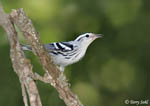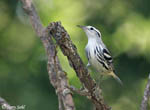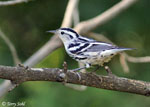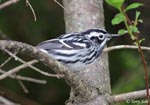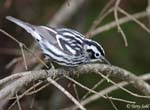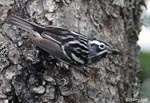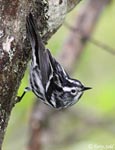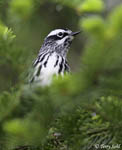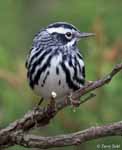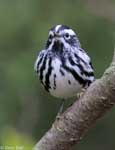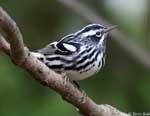| Length: 5 inches | Wingspan: 8.5 inches | Seasonality: Summer / Migrant |
| ID Keys: Nuthatch-like feeding behavior, black-and-white striping over entire body with white stripe over each eye. | ||
 A warbler that behaves like a nuthatch, the Black-and-White
Warbler feeds by crawling up and down tree trunks and branches, looking in
crevices for insects. They are often found quite low in forest and
woodland edges, a habit that makes them quite conspicuous, especially
considering their bold black-and-white plumage and unique behavior. A
common migrant in South Dakota, Black-and White Warblers are among the earliest
spring warblers.
A warbler that behaves like a nuthatch, the Black-and-White
Warbler feeds by crawling up and down tree trunks and branches, looking in
crevices for insects. They are often found quite low in forest and
woodland edges, a habit that makes them quite conspicuous, especially
considering their bold black-and-white plumage and unique behavior. A
common migrant in South Dakota, Black-and White Warblers are among the earliest
spring warblers.
Habitat:
Black-and-white Warblers breed in deciduous and mixed woodlands, both mature forest and second-growth forest. During migration and in winter, they are still primarily found in woodlands, but will also sometimes be found in parks, gardens, orchards, and other semi-vegetated habitats.
Diet:
Feeds almost exclusively on insects and spiders.
Behavior:
Does most of its foraging by clambering along tree branches and tree trunks in search of insects. They may climb upward as they forage like a Brown Creeper or go head first down a trunk like a nuthatch. Will also occasionally fly out from a perch to catch flying insects in mid-air.
Nesting:
June and July in South Dakota. The nest of a Black-and-white Warbler is a small cup, constructed of grasses, leaves, and weeds, and lined with finer material such as fine grasses, hair, and moss. It is typically placed on the ground in a protected location at the base of a stump or tree, next to a rock, or clump of vegetation. The female lays between 3 and 6 eggs, and she alone incubates them. The eggs hatch after 10 to 12 days, and the young fledge from the nest after another 10-12 days.
Interactive eBird Map:
Click to access an interactive eBird map of Black-and-White Warbler sightings
Song:
The song of a male Black-and-White Warbler is a high-pitched, thin weesy-weesy-weesy-weesy. They also have thin tseet calls.
1Click here to hear a singing male Black-and-white Warbler, taken in Washington County, Maine.
2Click here to hear a simple flight call of a Black-and-white Warbler, taken in Lake County, Minnesota.
Migration:
Summers in much of the eastern two-thirds of the United States and southern Canada. Winters along the Gulf Coast and points south, into northern South America.
Similar Species:
- Blackpoll Warbler - Both are black-and-white warblers with striping. However, Blackpoll Warblers have a solid black cap, while a Black-and-White warbler has a black-and-white striped cap. Blackpoll Warblers have a white cheek framed in black, while the Black-and-White Warbler male has a black cheek Black-and-white Warblers have a white eyebrow stripe above their eye, while Blackpoll Warblers are solid black above the eye.
- Black-throated Gray Warbler - A very uncommon species in South Dakota, but it shares an overall black-and-white striped appearance with the Black-and-White Warbler. Black-throated Gray Warblers have a solid gray back, while Black-and-White Warblers have a striped back. Facial patterns are similar between the two with a white eyebrow, extensive black through the eye and cheek (males), framed by a white stripe below. However, the Black-throated Gray Warbler male has a yellow spot in front of his eye.
Conservation Status:
Widespread and common, but there is some evidence of local declines from Breeding Bird Survey and other data. However, they're still found over a broad geographic area and populations are currently still strong. The IUCN considers the Black-and-White Warbler to be a species of "least concern".
Further Information:
1) USGS Patuxent Bird Identification InfoCenter, Black-and-White Warbler
2) WhatBird - Black-and-White Warbler
3) Audubon Guide - Black-and-White Warbler
Photo Information:
May 24th, 2012 - Acadia National Park, Maine - Terry Sohl
Additional Photos:
Click on the image chips or text links below for additional, higher-resolution Black-and-white Warbler photos.
Audio File Credits:
1Sue Riffe, XC382120. Accessible at www.xeno-canto.org/382120.
2Andrew Spencer, XC103496. Accessible at www.xeno-canto.org/103496
| Click on the map below for a higher-resolution view |
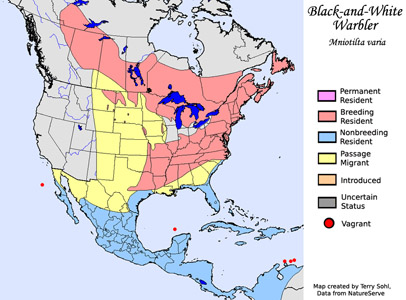 |
| South Dakota Status: Common migrant throughout the state. Uncommon and local summer resident in portions of the western part of the state, casual in summer in the east. |
Additional Black-and-white Warbler Photos
Click for a higher-resolution version of these photos
